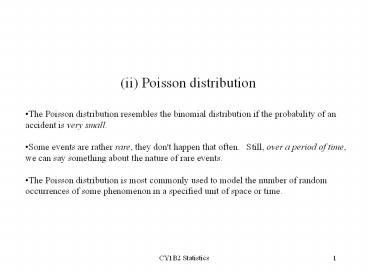ii Poisson distribution - PowerPoint PPT Presentation
1 / 16
Title:
ii Poisson distribution
Description:
Some events are rather rare, they don't happen that often. ... in above figure, with a digital voltmeter, taking a reading with a resolution d ... – PowerPoint PPT presentation
Number of Views:53
Avg rating:3.0/5.0
Title: ii Poisson distribution
1
- (ii) Poisson distribution
- The Poisson distribution resembles the binomial
distribution if the probability of an accident is
very small. - Some events are rather rare, they don't happen
that often. Still, over a period of time, we
can say something about the nature of rare
events. - The Poisson distribution is most commonly used to
model the number of random occurrences of some
phenomenon in a specified unit of space or time.
2
(ii) Poisson distribution
Let p become very small, n very large, but
finite.
then
which depends on r only
Mean value
Variance
The Poisson distribution applies to many physical
phenomena, such as radioactive decay, in which n
(the number of atoms) is very large but p (the
probability of a given atom decaying in a given
time) is very low.
3
6
Example Over a given period there are 10
cars on the road, and the probability of a given
car having an accident is 10 . Find the mean
number of accidents , and variance.
-4
Mean value
Variance
The standard deviation is then 10. This means a
10 rate in the accident rate over a given
period is not significant.
4
- Discrete Distribution A statistical
distribution whose variables can take on only
discrete values. - The mathematical definition of a discrete
probability function, p(x), must satisfies the
following properties. - The probability that x can take a specific value
is p(x). That is - p(x) is non-negative for all real x.
- The sum of p(x) over all possible values of x is
1.
5
- Continuous Distribution A statistical
distribution for which the variables may take on
a continuous range of values. The mathematical
definition of a continuous probability function,
f(x), satisfies the following properties - The probability that x is between two points a
and b is - It is non-negative for all real x.
- The integral of the probability function is
one, that is
6
What does this actually mean? Since continuous
probability functions are defined for an infinite
number of points over a continuous interval, the
area under the curve between two distinct points
defines the probability for that interval.
(Probabilities are measured over intervals, not
single points. The probability at a single point
is always zero.) The height of the probability
function can in fact be greater than one. The
property that the integral must equal one is
equivalent to the property for discrete
distributions that the sum of all the
probabilities must equal one.
7
- Continuous probability distributions
(i) Probability density
Suppose we sample a waveform as shown in above
figure, with a digital voltmeter, taking a
reading with a resolution dx (e.g. 0.1V), over
a period of time t.
8
- In order to intuitively develop the concept of
continuous probability function, we uses the
method of histogram, and then see how to define
continuous probability function from histogram. - A histogram is obtained by splitting the range of
the data into equal-sized bins (called classes).
Then for each bin, the number of points from the
data set that falls into each bin is counted.
That is - Vertical axis Frequency (i.e., counts for
each bin) - Horizontal axis Response variable
- The histogram has an additional variant whereby
the counts are replaced by the normalized counts.
The names for these variants are the relative
histogram and the relative cumulative histogram.
9
A histogram as shown above gives the number of
reading n versus range x. The right hand
side plots versus x, where n is
the total number of reading, when n becomes very
large.
10
The first step normalized count is the count in a
class divided by the total number of
observations. In this case the relative counts
are normalized to sum to one (or 100 if a
percentage scale is used). This is the intuitive
case where the height of the histogram bar
represents the proportion of the data in each
class. Or the probability of the data falling
into each range (each class). Sums up to one.
11
To get a smoother curve, reduce dx -?
0.1v,0.01v,0.001v, 0.0001v-? 0, such that each
range becomes infinitely small, but the problem
is that data points in every class nx/n ?0,
becomes negligible or ? 0. 2. The second step
normalized count is the count in the class
divided by the number of observations times the
class width. For this normalization, the area
(or integral) under the histogram is equal to
one.
The area under the curve is unity.
12
The resultant smooth curve is a plot of
probability density function p(x)
13
Clearly p(x)dx is the probability of a reading
being in a small range dx .
The probability of a reading between two values
The area under the curve is unity.
14
The expressions for the mean, mean square and
variance for continuous probability distribution
p(x) are
The mode value of x that corresponds to maximum
p(x) The Median value of x that divides plot
into equal areas.
15
Example Deduce the probability density for the
sawtooth waveform.
16
It can be deducted that the wave form moves
uniformly through all range of 0,A.































